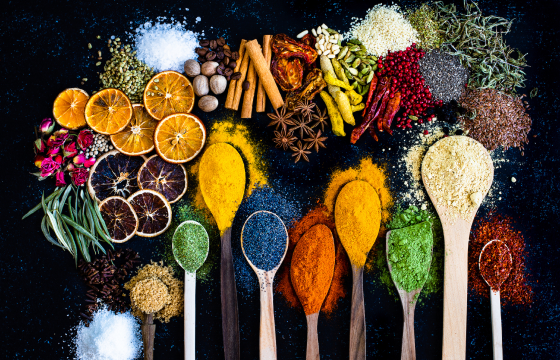Ingredients

Teeccino’s Ingredients
Teeccino is made from roasted herbs that are organically grown in the USA, Europe, Guatemala and India. Blended with fruits, nuts, herbs and spices to produce a wide variety of flavors, Teeccino comes in five distinctive blend families that are designed for different taste preferences and wellness benefits: Mediterranean, Maya, Dandelion and our new Mushroom Adaptogen and Prebiotic SuperBoost blends. Learn more about the herbs in Teeccino:

Carob
Carob pods, Ceratonia siliqua, are highly nutritious and contain a variety of antioxidants known as flavonoids. Carob shares flavonoids in common with tea that have been studied to be highly effective in humans for protecting cells against free radical damage. Maybe you’ve heard of carob pods being used as a chocolate alternative, but you may not realise that you probably eat carob frequently in common foods like ice cream and malt balls. The seeds in carob pods are used to make carob bean gum, also called locust bean gum, a stabiliser in many foods. You can find carob in the Bible referred to as St. John’s Bread. It is thought that humble carob pods, which taste naturally sweet, sustained St. John in the wilderness where carob trees grow wild throughout the Mediterranean and Middle East. A unique ingredient in carob, pinitol, may help reduce insulin resistance and keep blood sugar stable. The natural energy boost that people experience from drinking Teeccino may have something to do with pinitol helping cells take in more energy. Roasted carob pods have chocolate flavour notes with a sweetness that comes from their natural carbohydrates. Teeccino’s organic carob is imported from Italy and Spain where harvesting the pods from wild trees is a time-honored tradition.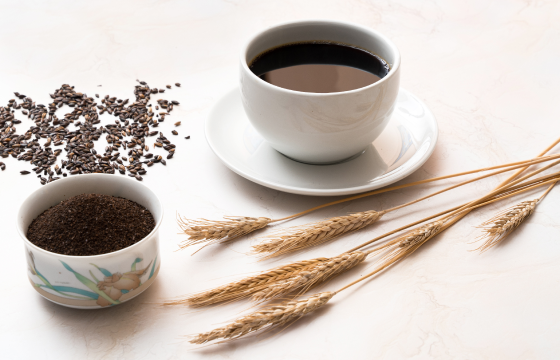
Barley
Barley, Hordeum vulgare, is a staple grain that is the fourth largest cereal crop grown in the world. An ancient grain that grew wild throughout Eurasia, the remains of cultivated barley has been dated back to 17,000 BCE (Paleolithic Europe). Roasted barley is a popular coffee alternative in Italy where it is known as “Caffé d’orzo”. Every coffee bar in Italy serves orzo brewed like cappuccinos or coffee! Barley contains antioxidants known as proanthocyanidins (OPCs) that are water-soluble and readily absorbable from a cup of Teeccino. You’ve probably read about the lower rate of heart disease in France despite their high consumption of saturated fats. The “French Paradox” has been attributed to OPCs that are found in red wine and some foods like barley. Although barley also contains gluten, brewed Teeccino is verified by independent laboratory tests as gluten-free by the University of Nebraska, the top gluten testing laboratory in the US. Organic barley used in Teeccino is grown both in the US and Europe.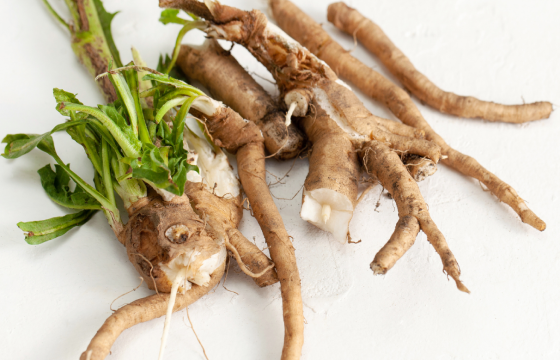
Chicory root
Roasted chicory root, Cichorium intybus, is one of Teeccino’s main ingredients. Chicory is the most popular coffee alternative in France. French coffee is famous for its smooth, less acidic flavour because approximately 30% of French coffee is roasted chicory root. Another variety of chicory produces endive, the leaves that are used as a green in salads. Teeccino is creating new trade by partnering to grow organic chicory in India with smallholder farmers who need a sustainable income crop to support their families. Chicory root contains the most inulin of any tuber. Inulin is a prebiotic that supports a healthy population of beneficial digestive flora in the intestines. Beverages made with roasted chicory root have a naturally occurring inulin content. Five grams of inulin per day is considered a healthy daily intake. The average Western diet supplies approximately 2.5 grams per day from common foods like wheat and garlic. Teeccino has 650 mg of inulin in each 10 oz mug so by drinking several servings of Teeccino a day, you can achieve the recommended daily dose for a prebiotic.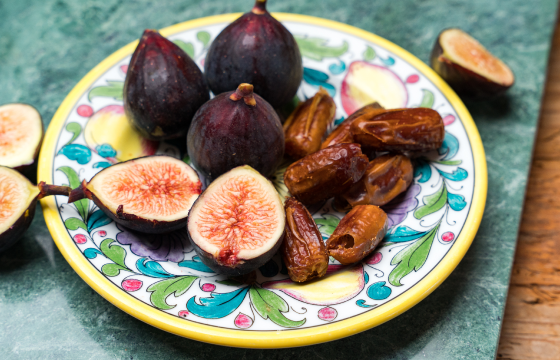
Dates and Figs
Teeccino’s Mediterranean flavours contain dates, Phoenix dactylifera, and figs, Ficus carica, to create a slightly sweet flavour without adding significantly to the calories per serving. With only 1g of sugar per serving, the Mediterranean flavours often don’t need additional sweetening for people who want to lower their calories yet still desire something that satisfies their sweet tooth. Both dates and figs contribute potassium and other nutrients that are water soluble and easily absorbable from a cup of Teeccino’s Mediterranean flavours. Potassium is a mineral that helps to control blood pressure. Many people do not eat enough fruits and vegetables. Instead, they consume foods and snacks high in sodium. As a result, they may be deficient in potassium. Low intake of potassium-rich foods, especially when coupled with a high intake of sodium, can lead to hypertension and other cardiovascular problems. Dates and figs both contain high amounts of antioxidants. Dates contain antioxidants known as proanthocyanidins (OPCs) that are water-soluble and readily absorbable from a cup of Teeccino. Figs have been shown to increase antioxidant capacity in humans for four hours after consumption. Both dates and figs are tree crops. Trees help prevent climate change by sequestering CO2 and creating oxygen through photosynthesis. Dates come from tall trees that survive extreme heat in the desert. Grown throughout the Middle East, date palms are also commercially grown in California. Teeccino’s figs are harvested from tree plantations in California.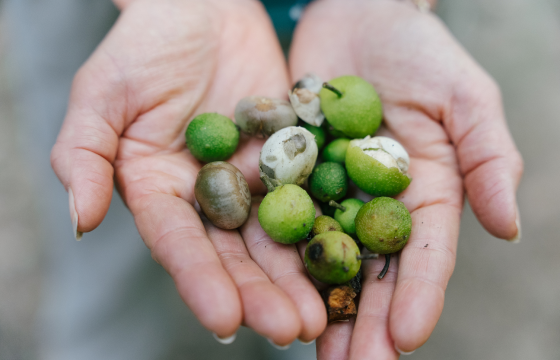
Ramón Seeds
Ramón seeds come from the fruit of the Brosimum alicastrum tree, which grows in Central American rainforests. At 130 feet tall, ramón trees are part of the upper forest canopy where monkeys and birds live. The ramón tree is a member of the fig family, which also includes mulberry trees. The seeds are nutrient-rich with nearly zero fat, most unusual for a seed! Ramón seeds were a traditional food of the Maya, whose name for the tree meant “the corn tree” since they ate the seeds like corn. The seeds could be dried and ground into flour and were capable of being stored for lengthy periods of time. The flour was blended with corn flour and the seeds were also roasted and drunk as a roasted beverage which was considered to be highly nutritious for pregnant women. Multiple names for ramón trees throughout Central America include Guaimaro, Mojo, Ojoche, Ojite, Ojushte, Ujuxte, Masica, Pisba, Waihka, Berba, Manchinga, Taju, Ox, Breadnut and Chokogou in other Central American cultures. Ramón seeds do not contain tree allergens like almonds, walnuts and pecans because they are the seed of a fruit, not a tree nut. People with sensitivity to almonds can drink Teeccino’s Maya flavours safely. Ramón seeds have twice the amount of calcium as corn, quinoa and oats, are high in fibre and high in potassium. Studies show that ramón seeds are very high in antioxidants and are comparable to walnuts, which have the highest level of antioxidants of any tree nuts. Roasted ramón seeds have a similar taste to coffee with some chocolate flavour notes. Its flavour as a raw seed is quite neutral like a potato. However, when roasted, the flavour of the seed is transformed and becomes like dark roasted coffee. The Maya were drinking a brew of roasted ramón seeds before the Spaniards ever brought coffee to America! Ramón flour is very high in potassium, fibre and tryptophan, the amino acid that helps calm stress, anxiety and depression. Fresh ramón seeds can be boiled like potatoes or dried and ground into a flour. The flour is fat-free and gluten-free making it an excellent addition to increase fibre and nutrients in baked goods. Teeccino has pioneered the harvest of ramón seeds in rural communities in the Maya Biosphere Reserve in Guatemala. By giving value to this seed, which once formerly going to waste on the forest floor, we have provided income opportunities for women and food for their families by educating them about how to prepare ramón seeds to make nutritious recipes. You can read more about Teeccino’s mission to create new trade that preserves rainforests and the educational and nutritional programs for women and children in Central America that we support on the US website www.teeccino.com.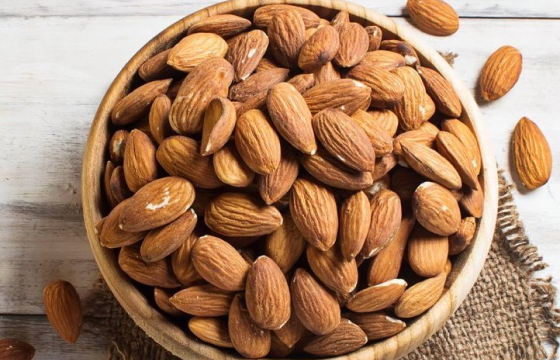
Almonds
Teeccino’s Mediterranean flavours contain golden roasted almonds that create a rich, nutty flavour yet don’t add any fat to a cup of Teeccino. Almonds are nutritionally dense food and contribute to the potassium in brewed Teeccino. They also have one of the highest contents of vitamin E of any commonly eaten foods. Along with their content of magnesium, calcium, phosphorus and iron, almonds make a heart-healthy and nutritious food. Almonds also contain significant quantities of antioxidants including proanthocyanidins (OPCs) and flavonoids called catechins that are also in green tea. Studies suggest that almonds have increased antioxidant potency by the synergistic combination of over 20 flavonoids with vitamin E, all in one little nut. Almond groves have been planted in the Central Valley of California, which has now become the largest growing region for almonds in the world. Teeccino’s almonds are harvested and roasted in California.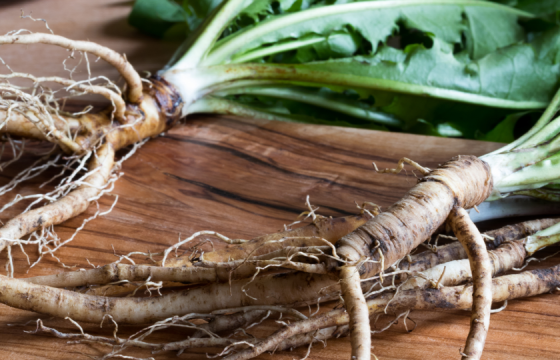
Dandelion Root
Roasted dandelion root, Taraxacum officinale, has a long history of use as a coffee alternative in Europe and the Americas. In the early 1800’s, several articles referred to pioneers drinking dandelion coffee in rural areas of the Americas where coffee wasn’t available. Later in the early 1900’s, roasted dandelion root was marketed as inexpensive coffee. Today, dandelion root coffee is enjoying a resurgence in popularity due to its reputation for stimulating the liver and bile flow and for being a diuretic. Dandelions have a long tap root that is dark brown on the outside, but milky white on the inside. Its bitter notes come from its glycoside, taraxacin, along with other terpenoids that are thought to have a beneficial effect on the liver and to stimulate the digestion. It has a reputation as a mild diuretic for which it earned the French common name, “pissenlit” or “wet the bed”. Dandelion root also contains polysaccharides and inulin, which may be responsible for some of the immune stimulating effects that dandelion root has been shown to have in some studies. The root’s inulin content is lower than chicory root, but still quite high compared to other sources in today’s diet. Some scientific studies show dandelion to be effective in blood sugar balancing. However, there are very few well constructed studies on dandelion root or leaf and thus it is hard to confirm many of its reputed health properties. The medicinal use of dandelions dates back to the Chinese where it was first mentioned in the Tang Materia Medica written in 659 B.C.E. Later it appears in medical journals written by Arab physicians in the 10th century. The botanical name may refer to the popularity of dandelion for many health disorders. It is derived from the Greek word “taraxos” which means disorder, combined with “akos” which is Greek for remedy. The German Commission E monograph for dandelion root and herb approves its use for “disturbance of the bile flow, stimulation of diuresis, loss of appetite, and dyspepsia.” In Teeccino Dandelion Herbal Coffees, dandelion root replaces barley to create 100% gluten-free herbal coffees. The organically grown dandelion root comes from Europe. There is a wide variation of qualities of roasted dandelion root, which is in short supply in any event. Purchasing only top quality, certified organic dandelion root is necessary to maintain Teeccino’s flavour standards, but limits our production of these boutique flavours.